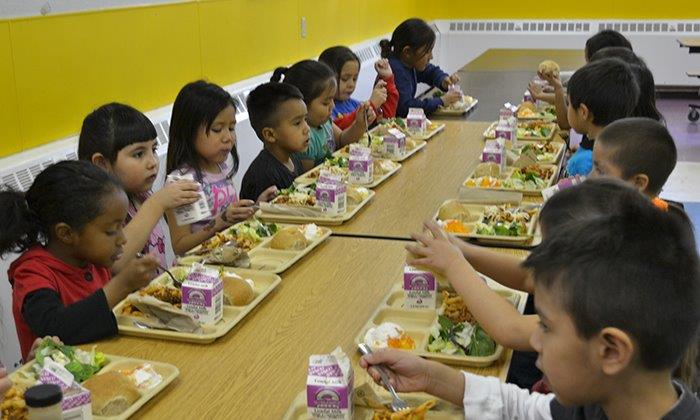
Native American children really enjoy the taste of Bison and the connection it gives them to their cultural heritage. There are many health benefits associated with eating bison meat,” says Dianne Amiotte-Seidel, project director/marketing coordinator for the InterTribal Buffalo Council.
USDA’s annual purchase of ground bison meat for utilization in the Food Distribution Program on Indian Reservations has topped $20 million, according to information provided to the National Bison Association this week by the agency’s Agricultural Marketing Service.
The Food Distribution Program on Indian Reservations (FDPIR) now offers traditional foods including bison, blue cornmeal, wild rice, wild salmon and catfish.
A purchasing summary this week documents that the agency has purchased 2.5 million lbs. of ground bison for a total of $21.4 million from fiscal year 2017 through fiscal year 2020.
The Food Distribution Program on Indian Reservations provides USDA Foods to income-eligible households living on Indian reservations and to Native American households residing in designated areas near reservations or in Oklahoma. USDA distributes both food and administrative funds to participating Indian Tribal Organizations and state agencies to operate FDPIR.
By introducing buffalo meat at 13 tribal schools, one company has been able to show students the health benefits while further connecting them with their cultural heritage.
A growing number of tribal communities are reconnecting children with their rich history and culture by establishing farm-to-school programs. In doing so, tribes are integrating traditional foods—like bison—into child nutrition programs.
Rich in flavor, low in fat and high in protein, buffalo meat is a good substitute for beef. It has significantly more iron with higher levels of vitamins and minerals and twice as much beta carotene as strictly grain-fed meats.
“There are many health benefits associated with eating bison meat,” says Dianne Amiotte-Seidel, project director/marketing coordinator for the InterTribal Buffalo Council (ITBC), who has spent nearly her entire professional career working to bring buffalo meat into tribal schools. “Plus, the taste is delicious and it’s a very versatile protein.”
Last year, ITBC, based in Rapid City, S.D., received a three-year Administration for Native Americans Grant to decrease the risk of diabetes by the incorporation of buffalo meat into children’s diets. ITBC also received a one-year USDA Farm to School Grant to assist schools on Indian reservations in South Dakota with the goal of procuring buffalo meat and fresh produce for their school lunch program, developing school gardens and developing educational curriculum.
“Once we had the grants, we began conducting onsite visits with 33 schools and the nine corresponding tribes to determine their ability to incorporate locally raised buffalo meat into school lunch programs,” says Amiotte-Seidel. “The assessments included the tribe’s and school’s infrastructure (cold storage, corrals, etc.), available buffalo, staff training levels and local support.”
Ultimately, 13 schools were able to participate in the program, and the results have been nearly all positive. But there have been a number of challenges—from supply to slaughter to prep methods to education—for ITBC to overcome.
“Many reservations are located in rural and remote areas with existing food systems challenged by a lack of infrastructure,” says Amoitte-Seidel. “But we’ve worked hard to sort these problems out and improve the chain to make access more feasible.”
After working closely with the USDA, Amoitte-Seidel was able to get approval for state-run slaughter houses to process the buffalo from local tribes for use in the schools.
“In many cases, there is no access to USDA plants near these reservations,” she explains. “Lower Brule (S.D.) Sioux Tribe had been transporting their bison four hours away to Sturgis to have it processed, then it had to be transported back. It was inefficient and complicated. Being able to use a state-run slaughter house closer to the reservation will make access easier for the schools currently participating and for others who would like to start.”
Another challenge Amoitte-Seidel has successfully overcome has been training the school nutrition professionals in the cafeterias about how to prepare the meat and talk with the students about its significance.
“Because buffalo meat is lower in fat, it cooks differently than traditional beef,” she says. “But we have held trainings for cooks, managers and superintendents where they come together, learn recipes and ways to prepare it properly and network with one another to share ideas and recipes.”
Education has been a key piece of the puzzle. It starts with arming the schools’ foodservice professional with knowledge about the tribe’s buffalo heritage, which they can relate to students and other staff. Then, once they’re comfortable cooking it, they incorporate it into menus where it best fits.
And at Flandreau (S.D.) Indian Schools, students were given the option of a beef patty or a bison patty. Many who were familiar with bison opted for that. Staff also experimented with the placement of meat on the hot line, but what they discovered was the more students learned about the health benefits and the history behind their tribe and buffalo meat, they were more likely to try it.
“St. Francis Indian School on the Rosebud Indian Reservation downplayed their use of bison to students in order to have a seamless transition,” says Amoitte-Seidel. “The cooks simply substituted buffalo meat for beef in spaghetti, chili, sloppy Joes and soup. When they explained to students that they were using the bison, the students were surprised and excited. Many commented on how buffalo is a rich part of their culture and that they couldn’t even taste the difference between buffalo and beef. They love the dishes are excited to continue trying new and different ones.”
Enemy Swim Day School (Waubay, S.D.), which serves Native American students in the Glacial Lakes region of northeast South Dakota, actually saw a reduction in food waste when it began incorporating buffalo meat into menus and it now serves the meat weekly.
And students at The Circle of Nation Boarding School (Wahpeton, N.D.) have enjoy the buffalo meat so much, they’ve requested it be on the menu more than once a week.
“The buffalo program has been a success on so many fronts,” says Amoitte-Seidel. “Students are really enjoying the taste of the bison and the connection it gives them to their cultural heritage.”
Newsletter, Joanna DeChellis, Feb 21, 2017

Francie M Berg
Author of the Buffalo Tales &Trails blog


